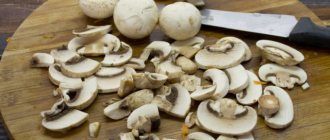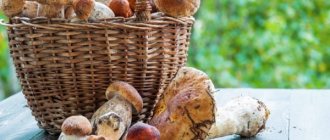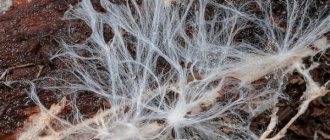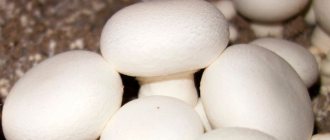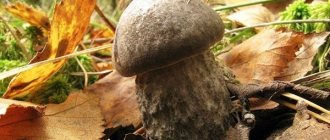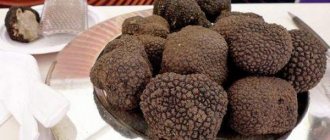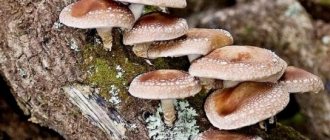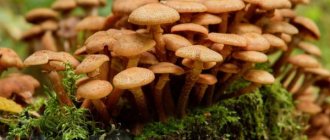Mushrooms
0
1414
Article rating
Kira Stoletova
There is such a thing as bioluminescence - the glow of living organisms. Glowing mushrooms are part of this phenomenon. Some species glow not only in the dark, but also during the day. Science gives different explanations for this phenomenon.
The phenomenon of glowing mushrooms
General information
Glowing mushrooms were first discovered in 1840 in Brazil. Then they disappeared and over time, luminescent fruiting bodies were discovered again in the same place. Mentions of the phenomenon are found even in the works of the ancient scientist Aristotle and the writer Pliny the Elder.
Among these species there are many poisonous organisms. The size of the mushroom caps does not exceed 3 cm in diameter. The most common is Mycena (feeds and decomposes organic matter). The radiation is often yellowish-green, but can also be light blue, deep red, etc. They are found in the forests of Japan, South America, Brazil, Belize, Puerto Rico and Jamaica, Southern Europe, etc.
Bleeding tooth
Or Hydnellum peckii. But no one wants to eat this terrifying mass. And it’s very good that you don’t want to - the mushroom has an incredibly bitter taste. Hydnellum peck is more common than glow or blue mushrooms - it can be found in the fall in the coniferous forests of North America, the Pacific Northwest, Europe, Iran and Korea.
Bleeding tooth / ©Flickr
Reasons for the glow
More often the entire fruiting body glows. In our latitudes there are mushrooms with luminous mycelium. Scientific research has revealed conflicting reasons for this phenomenon:
- Chemical reaction: the pigment luciferin and oxygen are involved in the process. The pigment oxidizes and causes a greenish glow.
- Habitat: features of the place where the fungus grows.
- Method of spreading spores: attracting nocturnal animals, on whose fur the spores fall and are thus spread throughout the forest.
- Method of warning: light warns of the toxicity of fruiting bodies. But a defensive reaction is not always justified, because they may turn out to be edible.
The glow of most species is weak, visible only in the dark. But there are also mushrooms that, thanks to their flickering, can be visible at a distance of 30 m. They are called Poromycena manipularis.
The entire fruiting body usually glows
The strength of different types of radiation depends on the following factors:
- life cycle duration;
- age of the fruiting body: old mushrooms no longer glow, unlike young ones;
- ambient temperature: the most intense bioluminescence of these fungi is observed at +21˚С;
- the amount of oxygen in the air: the less it is, the weaker the glow.
Bioluminescence - what is it and why can mushrooms glow?
At first glance, the phenomenon of bioluminescence seems very complex and incomprehensible to the average person. It seems so until a decoding of this concept appears, because this is just the phenomenon of the glow of a certain living object in the natural environment. Representatives of the phenomenon can be not only plants or mushrooms, but also animals, and sometimes people. What is the essence of the phenomenon and how can this be explained using the example of bioluminescent mushrooms? We'll tell you more!
Most common types
Glowing mushrooms have recently been represented by 68 species. But every year the number of discovered species with this property increases. The most famous include the following:
- Mycena luxaeterna: found along the Atlantic coast. They grow on tree branches. The diameter of the cap is 0.8 cm. The stem is jelly-like. The name translates as “eternal light.”
- Mycena silvaelucens: species found on the island of Borneo (Malaysia). Cap dimensions – 18 mm.
- Mycena luxarboricola, or tree light: a species of luminous mushroom, the first specimens of which were found in Brazil. Most common on the Parana River. The diameter of the cap is 0.5 cm.
- Poromycena manipularis: Small sized mushrooms have been found in Australia, Malaysia and the Pacific Islands. The mycelium and fruiting bodies of this species are bioluminescent. The yellow-green glow they emit can be seen at a distance of up to 30 m.
- Pleurotus (Agaricus) olearius DC: native to Southern Europe. They prefer places under old trees. The fruit bodies are large, the stem is thick, the cap is yellow-golden. Entire fruiting bodies glow.
- Xylaria Hypoxylon L: grows on beech stumps. The glow comes from the mycelium. The fruiting bodies are usually branched.
- Armillaria mellea Vahl: The mycelium of this species destroys wood. Light and dark threads of mycelium permeate the entire trunk. The glow in the dark makes it appear as if the radiation is coming from the tree.
- Neonothopanus gardneri, or "palm blossom" : The mushrooms are found in Brazil. They grow at the base of palm trees. Until 2009, the species was called Agaricus gardneri.
Glowing mushrooms come in many varieties
Comb blackberry
But this mushroom (Hericium erinaceus), which looks like a bobtail dog, can be eaten. And it grows not so far from our regions - in the Amur region, Khabarovsk and Primorsky territories, in the north of China, in the foothills of the Caucasus and in the Crimea. It tastes like... shrimp meat. This mushroom is also used for medical purposes - to increase immunity, treat chronic gastritis, cancer of the esophagus, stomach and leukemia. It is found in deciduous forests from August to October, but, alas, is rare, so it is even listed in the “Red Book” of Primorye and the Jewish Autonomous Region. Therefore, comb blackberries are often grown artificially.
Blackberry / ©Flickr
Application
Glowing mushrooms are sometimes used in medicine.
Dictyophora luminosa, a rare species that grows in the jungle, has medicinal properties. According to the recipe of Count Alessandro Cagliostro, an elixir is prepared from it, which requires the following ingredients:
- 4 g dry chopped dictyophora;
- 200 g vodka or cognac;
The medicine is infused for 2 weeks. Take orally 1 hour or 1 tbsp. l. 3 times a day 15 minutes before meals. It can help in the treatment of a variety of diseases and can:
- fight cancer cells;
- give a rejuvenation effect;
- help in the treatment of cardiovascular diseases;
- enhance potency.
Today, scientists from Russia, together with Brazilian and Japanese colleagues, have created mushrooms that glow in almost all the colors of the rainbow. Decorative lanterns made from such mushrooms, hanging from tree trunks or placed on the ground, can decorate gardens.
Irina Selyutina (Biologist):
The glow of mushrooms is noticeable only in the dark; it can be either strong or very weak (it can only be noticed during special photography). Bioluminescence is the ability of living organisms (no matter what) to glow independently or with the help of symbionts. This process is based on chemical reactions in which energy is released, not in the form of heat, but in the form of light.
Doctor of Chemical Sciences, Ilya Viktorovich Yampolsky and his team of specialists from the Moscow Institute of Bioorganic Chemistry of the Russian Academy of Sciences, managed to find out that luminous mushrooms contain a special - ninth type of luciferin, which is sharply different from those already described by specialists and is a first for the kingdom of Mushrooms. Yampolsky believes that this type of luciferin is compatible with substances that are used in plant biochemistry, which will result in the creation of autonomous luminous plants that can become alternative night lighting. This will happen due to the fact that such plants will independently synthesize luciferin.
It’s worth trying to grow a glowing mushroom with your own hands. To get a quality harvest, you need good seedlings. Luminescent fruiting bodies are rare, so sticks with mycelium are bought at special enterprises or in stores. We must remember that in nature such species grow more often in the humid tropics. The mycelium will begin to bear fruit if you create a microclimate corresponding to the natural one in a room intended for growing such amazing mushrooms.
Mutinus canis
Not only does this mushroom have an unattractive name, but it also looks... somehow indecent. This is understandable, because the name of this mushroom, Mutinus caninus, comes from the Roman phallic deity Mutinus Mutunus, which means “like a dog.” The funny thing is that it is edible, however, only at a young age, when it is still in the ovoid shell and does not look so provocative. Despite the fact that the mushroom is listed in the Red Book, it, although very rarely, can be found from July to October in Karelia, Leningrad, Stavropol and Tomsk regions, Primorsky and Krasnodar Territories, Estonia, Lithuania, Ukraine, Georgia and Armenia, as well as North America. Loves rotten wood, stumps, sawdust.
Mutinus canis / ©Flickr
Tricks of chemistry or science is to blame for everything
Focusing on the scientific component and trying to protect yourself from miracles, you can explain the glowing effect of the mushrooms, so mysterious in the photo, by a banal chemical reaction. It involves the participation of only two components in the process: the pigment luciferin and oxygen.
The oxidation of the biological pigment is what causes the bioluminescence of the fungus, the appearance of greenish light in the dark in these eukaryotes.
But this is far from the only version of the glow. One should not discount the possibility that the color of mushrooms depends on natural conditions and their distribution area.
Definitioner
rare (rare smell)
In mycology, rare smell, English. "raphanoid" is interpreted very loosely and often refers to any smell of raw root vegetables, including potatoes, i.e. not necessarily as sharp, pungent and fresh as black or white radish.
Basidia (Basidia)
Lat. Basidia. A specialized structure of sexual reproduction in fungi, unique to basidiomycetes. Basidia are terminal (end) elements of hyphae of various shapes and sizes, on which spores develop exogenously (outside).
Basidia vary in structure and method of attachment to hyphae.
Based on the position relative to the axis of the hyphae to which they are attached, three types of basidia are distinguished:
Apical basidia are formed from the terminal cell of the hypha and are located parallel to its axis.
Pleurobasidia are formed from lateral processes and are located perpendicular to the axis of the hypha, which continues to grow and can form new processes with basidia.
Subbasidia are formed from a lateral process turned perpendicular to the hyphal axis, which stops growing after the formation of one basidium.
Based on morphology:
Holobasidia are single-celled basidia, not divided by septa (see Fig. A, D).
Phragmobasidia are divided by transverse or vertical septa, usually into four cells (see Fig. B, C).
By type of development:
The heterobasidium consists of two parts - the hypobasidium and the epibasidium developing from it, with septations (see Fig. C, B) or without them (see Fig. D).
Homobasidia is not divided into hypo- and epibasidia and in all cases is considered to be holobasidium (Fig. A).
The basidium is the site of karyogamy, meiosis, and the formation of basidiospores. Homobasidy, as a rule, is not functionally divided, and meiosis follows karyogamy. However, the basidia can be divided into probasidium, the site of karyogamy, and metabasidium, the site of meiosis. Probasidium is often a resting spore, for example in rust fungi. In such cases, the probasidium germinates into a metabasidium, in which meiosis occurs and on which basidiospores are formed (see Fig. E).
See Karyogamy, Meiosis, Hypha.
PileipellisLat. Pileipellis, skin - a differentiated surface layer of the cap of agaricoid basidiomycetes. The structure of the skin in most cases differs from the inner flesh of the cap and may have a different structure. The structural features of pileipellis are often used as diagnostic characters in descriptions of fungal species.
Based on their structure, they are divided into four main types: cutis, trichoderma, hymeniderma and epithelium.
See Agaricoid fungi, Basidiomycete, Cutis, Trichoderma, Hymeniderma, Epithelium.
Hymeniderma
A type of cap skin, consists of nonseptate elements located more or less perpendicular to the surface and laid at the same level, resembling the hymenial layer.
Lat. Hymeniderm.
It is divided into trichohymeniderma, euhymeniderma, and epithelioid hymeniderma.
There is also a transitional structure of the skin from the hymeniderm to the epithelium. (A mixture of round cells, characteristic of the epithelium, but located in one layer, and pear-shaped cells, characteristic of the hymenidermis, lying at the same level.)
See Hymenial layer, Trichohymeniderm, Euhymeniderm, Epithelioid hymeniderm, Epithelium, Septa.
Definitioner
Paraphyses (Paraphyses)
Multicellular or unicellular non-spore-bearing outgrowths in some algae, fungi and mosses that protect the reproductive or spore-bearing organs from drying out and mechanical damage.
Paraphysis (Paraphysis)
Multicellular or unicellular non-spore-bearing outgrowths in some algae, fungi and mosses that protect the reproductive or spore-bearing organs from drying out and mechanical damage.
Apothecia (Apothecia)
The type has a completely open ascocarp, often saucer- or goblet-shaped. On the surface of the apothecium there is an ordered hymenial layer, consisting of bags and sterile elements - the paraphysis; under it lies the subhymenial layer, in which the asci develop, and everything else consists of sterile hyphae of the pulp - the excipule. Apothecium is characterized by the simultaneous maturation of many asci and the active release of spores. Secondary closed apothecia are found in mushrooms whose fruiting bodies develop underground, for example, in truffles.
See Ascocarp, Hymenium, Discomycetes, Paraphysa.
Apothecia (Apothecia)
The type has a completely open ascocarp, often saucer- or goblet-shaped. On the surface of the apothecium there is an ordered hymenial layer, consisting of bags and sterile elements - the paraphysis; under it lies the subhymenial layer, in which the asci develop, and everything else consists of sterile hyphae of the pulp - the excipule. Apothecium is characterized by the simultaneous maturation of many asci and the active release of spores. Secondary closed apothecia are found in mushrooms whose fruiting bodies develop underground, for example, in truffles.
See Ascocarp, Hymenium, Discomycetes, Paraphysa.
Apothecia (Apothecia)
The type has a completely open ascocarp, often saucer- or goblet-shaped. On the surface of the apothecium there is an ordered hymenial layer, consisting of bags and sterile elements - the paraphysis; under it lies the subhymenial layer, in which the asci develop, and everything else consists of sterile hyphae of the pulp - the excipule. Apothecium is characterized by the simultaneous maturation of many asci and the active release of spores. Secondary closed apothecia are found in mushrooms whose fruiting bodies develop underground, for example, in truffles.
See Ascocarp, Hymenium, Discomycetes, Paraphysa.
Bags (Ask)A specialized cell of marsupial fungi (ascomycetes), inside which ascospores develop as a result of the sexual process.
The structure of the bags is an important diagnostic feature used in the ascomycete system. There are prototunicate and eutunicate asci. The former have a thin shell, not divided into layers, which blurs when the ascospores mature, and they are released passively. The latter have a more dense, layered shell, equipped with a specialized apical apparatus for opening, and the ascospores are actively discarded.
Among the eutunicate asci, there are unitunicate asci, whose shell layers grow together and open simultaneously, and bitunicate asci, whose shell consists of two sequentially opening layers. Further division of the unitunicate bursae is based on the structure of the apical apparatus.
See Apical apparatus.
Defensiveness or desire to survive
According to the authoritative opinions of some scientists, luminous mushrooms owe their color to the natural conditions in which they grow. There are two main and at the same time radically opposite versions that explain luminescence.
Reproduction. Glowing mushrooms has become the main means of attracting animals to them. When they fall on the fur of a night visitor, fungal spores are spread throughout the forest. This is exactly how their reproduction occurs.
Repellent. So attractive in the photo, mushrooms that emit light in the dark warn animals of danger and clearly indicate the toxicity of the mushroom. This forces fauna to stay away from them.
Glow-in-the-dark mushrooms rediscovered after 170 years
It's hard to imagine that such a natural wonder could be completely lost sight of, but some of the most brilliantly glow-in-the-dark mushrooms have been rediscovered after more than 170 years of absence.
Bioluminescent mushrooms have become something of a legend in Brazil. They were first discovered in 1840 by an English botanist named George Gardner. He noticed a strange glowing object that children were playing with on the street of Vila de Natividad, a settlement in the state of Goiás in Central Brazil. After this, there were no reports of brightly glowing mushrooms.
The strange fungus was almost completely forgotten until 2002, when Brazilian chemist Cassius Stevani came across Gardner's previously recorded reports. Then, in 2005, a scientific discovery happened. Primatologists Patricia Isar of the University of São Paulo in Brazil and Dorothy Fragasi of the University of Georgia in Athens were studying a troop of monkeys deep in the interior of Brazil when they saw something mysteriously glowing at the root of a palm tree.
Izar and Fragasi collected mushroom samples and gave them to Stevani, who later confirmed that the mushrooms they found were in fact Gardner's long-lost plant. It was this find that became the basis for an article in the next issue of the journal “Mycology”.
Adding to the irony of the situation is the fact that immediately after the rediscovery of the mushrooms, scientists found out that the local population was very familiar with them. In fact, the mushrooms even had a name - flor-de-coco, or coconut flower, as they are most often found on the rotting side of chamerops palms. As often happens in such cases, scientists never asked why it was there.
Bioluminescence - simply put, the ability of organisms to emit light - is a widespread phenomenon. Jellyfish and fireflies are probably the most famous bioluminescent creatures, but creatures from bacteria and fungi to insects and fish produce light through a variety of chemical processes.
Bioluminescent mushrooms have been known for centuries, from the orange-red talker to a phenomenon known as “phosphorescent light,” where nutrient-absorbing fibers of honey mushroom give off a faint but eerie glow in rotten trees. Glowing mushrooms have captured the imagination of cultures around the world. Most often, people are afraid of them, calling them “ghost mushrooms.”
Although luminous mushrooms are not new to science - 71 species of mushrooms with such properties have been found - this particular species (it is named Neonothopanus gardneri in honor of its discoverer) is distinguished by its size and extraordinary intensity of glow.
“It glows brighter than almost all other luminescent mushrooms,” explains Dennis Desyardin, a mushroom specialist at San Francisco State University. “If you put such a mushroom on a newspaper in a dark room, you will be able to read the words.”
Desyardin also noted that these mushrooms grow up to 8 centimeters in diameter, which is simply gigantic compared to other bioluminescent mushrooms.
Stevani is currently working to find the chemical compounds that give these fungi the ability to emit light. This natural system still remains a mystery to science. Researchers believe that the mechanism for producing light in mushrooms is the same as fireflies, using a chemical mixture of luciferin and luciferase. The last chemical is an enzyme that helps luciferin, oxygen and water interact to produce a new compound that emits light. However, scientists have not yet discovered luciferin and luciferase in mushrooms.
Scientists also don't know for sure why the glow occurs. One theory is that the mushrooms glow to attract insects, which helps spread spores. Another theory, also involving insect attraction, suggests that the light is a warning light for predatory beetles that feed on insects that can damage the mushroom.
However, what scientists are absolutely sure of is that such mushrooms are poisonous. And since people are interested in the glow-in-the-dark properties of mushrooms, researchers strongly recommend not eating them.
